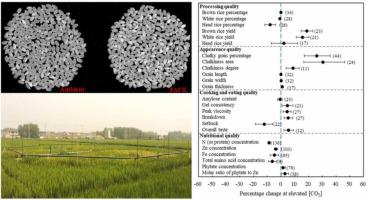Field Crops Research ( IF 5.8 ) Pub Date : 2022-05-18 , DOI: 10.1016/j.fcr.2022.108562 Shaowu Hu , Kaicheng Tong , Wang Chen , Yunxia Wang , Yulong Wang , Lianxin Yang

|
Compared with growth and yield, far less attention has been devoted to the impact of elevated CO2 on rice grain quality. Exposure to elevated CO2 induces numerous physiological changes in plants that can alter the chemical composition and thus the quality of rice grains. This meta-analysis was conducted to synthesize the effect of free air CO2 enrichment (FACE, approximately 550 μmol mol−1) on grain quality of rice grown under open field conditions. Factors that could modify the CO2 effects were also investigated. They included cultivars, nitrogen applications, environmental temperatures and grain types. On average, elevated CO2 decreased head rice percentage by 8%, which led to no increase in head rice yield, despite substantial increases of brown rice yield and white rice yield that were obtained under FACE conditions. Elevated [CO2] increased chalky grain percentage by 26% and chalkiness degree by 30%, which significantly impaired rice appearance. However, the cooking and eating quality was improved by elevated [CO2], as indicated by the changes in starch RVA profiles and the palatability of cooked rice. The nutritional value of FACE rice declined as shown by the 2–9% decreases in the concentrations of nitrogen, phosphorus, magnesium, sulfur, zinc, iron, copper, manganese and amino acids; meanwhile the anti-nutrient phytate and the molar ratio of phytate to zinc were increased. High nitrogen application alleviated negative effects of elevated [CO2] on milling quality and rice appearance but further decreased the bioavailability of essential nutrients. The CO2-induced decreases in element concentrations of white rice were generally higher than those in brown rice. In general, CO2-induced changes on grain quality were seldom modified by rice cultivars, temperatures or experimental locations.
中文翻译:

稻谷品质对大气 CO2 浓度升高的响应:20 年 FACE 研究的荟萃分析
与生长和产量相比,人们对CO 2升高对稻谷品质的影响关注较少。暴露于升高的 CO 2会导致植物发生许多生理变化,这些变化可以改变化学成分,从而改变稻谷的质量。进行该荟萃分析以综合自由空气CO 2富集(FACE,约550 μmol mol -1)对露地条件下生长的水稻籽粒品质的影响。还研究了可以改变 CO 2效应的因素。它们包括品种、施氮量、环境温度和谷物类型。平均而言,升高的 CO 2尽管在 FACE 条件下糙米产量和白米产量大幅增加,但整粒米百分比降低了 8%,这导致整粒稻产量没有增加。升高的[CO 2 ] 使白垩粒百分比增加26%,白垩度增加30%,显着损害稻米外观。然而,通过升高 [CO 2],正如淀粉 RVA 谱的变化和米饭的适口性所表明的那样。FACE 大米的营养价值下降,表现为氮、磷、镁、硫、锌、铁、铜、锰和氨基酸浓度下降 2-9%;同时提高了抗营养植酸盐和植酸盐与锌的摩尔比。高施氮量减轻了[CO 2 ] 升高对碾米质量和稻米外观的负面影响,但进一步降低了必需营养素的生物利用度。CO 2引起的白米元素浓度下降普遍高于糙米。一般来说,CO 2水稻品种、温度或试验地点很少改变由谷粒质量引起的变化。



























 京公网安备 11010802027423号
京公网安备 11010802027423号